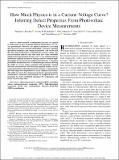| dc.contributor.author | Kurchin, Rachel C. | |
| dc.contributor.author | Poindexter, Jeremy R. | |
| dc.contributor.author | Vahanissi, Ville | |
| dc.contributor.author | Savin, Hele | |
| dc.contributor.author | del Canizo, Carlos | |
| dc.contributor.author | Buonassisi, Tonio | |
| dc.date.accessioned | 2022-02-08T19:36:17Z | |
| dc.date.available | 2021-12-14T19:58:13Z | |
| dc.date.available | 2022-02-08T19:36:17Z | |
| dc.date.issued | 2020-08 | |
| dc.identifier.issn | 2156-3381 | |
| dc.identifier.issn | 2156-3403 | |
| dc.identifier.uri | https://hdl.handle.net/1721.1/138484.2 | |
| dc.description.abstract | Defect-assisted recombination processes are critical to understand, as they frequently limit the photovoltaic (PV) device performance. However, the physical parameters governing these processes can be extremely challenging to measure, requiring specialized techniques and sample preparation. And yet the fact that they limit performance as measured by current-voltage (JV) characterization indicates that they must have some detectable signal in that measurement. In this work, we use numerical device models that explicitly account for these parameters alongside high-throughput JV measurements and Bayesian inference to construct probability distributions over recombination parameters, showing the ability to recover values consistent with previously reported literature measurements. The Bayesian approach enables easy incorporation of data and models from other sources; we demonstrate this with temperature dependence of carrier capture cross-sections. The ability to extract these fundamental physical parameters from standardized, automated measurements on completed devices is promising for both established industrial PV technologies and newer research-stage ones. | en_US |
| dc.language.iso | en | |
| dc.publisher | Institute of Electrical and Electronics Engineers (IEEE) | en_US |
| dc.relation.isversionof | http://dx.doi.org/10.1109/jphotov.2020.3010105 | en_US |
| dc.rights | Creative Commons Attribution-Noncommercial-Share Alike | en_US |
| dc.rights.uri | http://creativecommons.org/licenses/by-nc-sa/4.0/ | en_US |
| dc.source | Other repository | en_US |
| dc.title | How Much Physics is in a Current–Voltage Curve? Inferring Defect Properties From Photovoltaic Device Measurements | en_US |
| dc.type | Article | en_US |
| dc.identifier.citation | Kurchin, Rachel C, Poindexter, Jeremy R, Vahanissi, Ville, Savin, Hele, del Canizo, Carlos et al. 2020. "How Much Physics is in a Current–Voltage Curve? Inferring Defect Properties From Photovoltaic Device Measurements." IEEE Journal of Photovoltaics, 10 (6). | en_US |
| dc.contributor.department | Massachusetts Institute of Technology. Photovoltaic Research Laboratory | |
| dc.contributor.department | Massachusetts Institute of Technology. Department of Materials Science and Engineering | |
| dc.relation.journal | IEEE Journal of Photovoltaics | en_US |
| dc.eprint.version | Author's final manuscript | en_US |
| dc.type.uri | http://purl.org/eprint/type/JournalArticle | en_US |
| eprint.status | http://purl.org/eprint/status/PeerReviewed | en_US |
| dc.date.updated | 2021-12-14T19:54:18Z | |
| dspace.orderedauthors | Kurchin, RC; Poindexter, JR; Vahanissi, V; Savin, H; del Canizo, C; Buonassisi, T | en_US |
| dspace.date.submission | 2021-12-14T19:54:19Z | |
| mit.journal.volume | 10 | en_US |
| mit.journal.issue | 6 | en_US |
| mit.license | OPEN_ACCESS_POLICY | |
| mit.metadata.status | Authority Work Needed | en_US |
